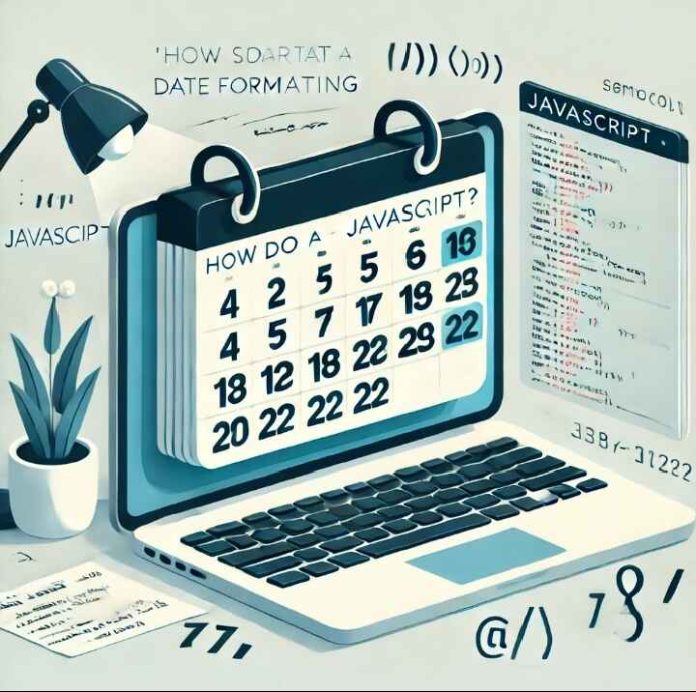When working with JavaScript, manipulating and formatting dates is a common task in web development. While JavaScript provides built-in tools to handle dates, formatting them to meet your requirements often involves a bit of customization. This guide will walk you through various methods to format dates in JavaScript, from using native methods to leveraging powerful libraries.
1. Using the Native JavaScript Date Object
The JavaScript Date object offers methods to extract individual parts of a date, such as the day, month, and year, which you can combine to format dates.
Example: Manually Formatting a Date
const date = new Date();
const day = date.getDate();
const month = date.getMonth() + 1; // Months are zero-based
const year = date.getFullYear();
const Formatted Date = `${month}/${day}/${year}`;
console.log(Formatted Date); // Output: e.g., “1/9/2025”
Here’s what happens:
Get Date() fetches the day of the month.
Get Month() retrieves the month (0-based, so January is 0).
Get Full Year() gives the four-digit year.
Example: Adding Leading Zeros
To ensure the date components have consistent formatting, such as 01/09/2025 instead of 1/9/2025:
const Pad Zero = (num) => String(num).Pad Start(2, ‘0’);
const Formatted Date = `${padZero(month)}/${padZero(day)}/${year}`;
console.log(Formatted Date); // Output: “01/09/2025”
2. Using toLocaleDateString()
JavaScript’s toLocaleDateString() is a built-in method that formats dates according to a locale.
Example: Simple Locale Formatting
const date = new Date();
console.log(date.toLocaleDateString(‘en-US’)); // Output: “1/9/2025” (MM/DD/YYYY)
console.log(date.toLocaleDateString(‘en-GB’)); // Output: “09/01/2025” (DD/MM/YYYY)
Example: Customizing the Format
You can customize the output using options:
const options = { year: ‘numeric’, month: ‘long’, day: ‘numeric’ };
console.log(date.toLocaleDateString(‘en-US’, options));
// Output: “January 9, 2025”
Available options include:
weekday: e.g., “long”, “short”, “narrow”
year: “numeric” or “2-digit”
month: “numeric”, “2-digit”, “long”, “short”, “narrow”
day: “numeric” or “2-digit”
3. Using Intl.DateTimeFormat
For more control, use the Intl.DateTimeFormat API. It’s similar to LocalDateString() but allows for reusability.
Example:
const formatter = new Intl.DateTimeFormat(‘en-US’, { year: ‘numeric’, month: ‘2-digit’, day: ‘2-digit’ });
console.log(formatter.format(new Date())); // Output: “01/09/2025”
4. Using Third-Party Libraries
While native methods are useful, formatting dates can get complicated. Libraries like Moment.js, date-fns, or Day.js simplify the process.
Example with date-fns
Install date-fns via npm:
npm install date-fns
Format a date:
import { format } from ‘date-fns’;
const date = new Date();
const Formatted Date = format(date, ‘MM/dd/yyyy’);
console.log(Formatted Date); // Output: “01/09/2025”
Example with Day.js
Install Day.js via npm:
npm install dayjs
Format a date:
import dayis from ‘dayjs’;
const date = dayjs();
console.log(date.format(‘MM/DD/YYYY’)); // Output: “01/09/2025”
5. Which Method Should You Use?
Native Methods: Best for simple use cases and lightweight scripts.
toLocaleDateString(): Ideal for localization and quick formatting.
Intl.DateTimeFormat: Great for reusable formatting patterns.
Third-Party Libraries: Best for complex date manipulations and robust applications.
Conclusion
Formatting dates in JavaScript can range from simple to sophisticated depending on your requirements. Native methods provide flexibility, while libraries like date-fns or Day.js save



